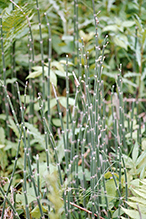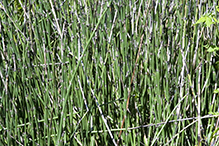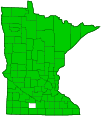scouring rush horsetail
(Equisetum hyemale ssp. affine)
Conservation • Wetland • Description • Habitat • Ecology • Use • Distribution • Taxonomy
Description |
||
Scouring rush horsetail is an erect, evergreen, unbranched perennial that rises from rhizomes. It can be 8″ to 60″ tall, though in Minnesota it is usually 24″ to 48″ tall. It often forms dense colonies. The stems are erect, ⅛″ to ½″ in diameter, dark green, and hollow. They are normally unbranched, but may develop one or a few branches after injury, or in the second year. They have 14 to 50 fine, vertical ridges with silica deposits making them rough to the touch. They are evergreen, lasting more than one year. The central cavity is at least ¾ the diameter of the stem. The portion of the stem between the nodes is up to several inches near the bottom, becoming progressively shorter as they ascend the stem. The leaves are reduced in size, fused together for most of their length, and appressed against the stem, forming a collar-like sheath around the nodes. The main sheaths are tan, grayish, or white, with a black band at both the base and the tip. They are wider than long, 3 ⁄16″ to ⅜″ long, ⅛″ to ¾″ wide, and appear squarish. At the tip of the sheath are 14 to 50 free, 3 ⁄16″ long or less lobes appearing as tiny, black teeth. The teeth are jointed and may fall off at the joint at maturity, leaving just a dark rim on the sheath, but they often persist. A solitary, spore-bearing cone is borne at the end of each fertile stem. The cone is ⅜″ to 1″ long, circular in cross-section, and elliptic in long section. It ends with a small but conspicuous, abrupt, flexible point at the tip (apiculate). Infertile stems are similar to fertile stems but lack the terminal cone. The cone falls off after releasing spores. |
||
Height |
||
8″ to 60″ |
||
Similar Species |
||
Smooth scouring rush (Equisetum laevigatum) is a shorter plant, only reaching 12″ to 36″ tall. The stems are lighter green, smooth to the touch, and annual. The sheaths are light green and have a black band at the tip only, sometimes also the lowest ones with a black band at the base or black throughout. The teeth on the sheath fall off promptly at maturity. The cones are inconspicuously apiculate. Variegated scouring rush (Equisetum variegatum ssp. variegatum), is a much shorter plant, only 4″ to 18″ tall. The stems are much thinner, 1 ⁄32″ to 3 ⁄32″ in diameter. The sheaths are green with a black band at the tip, and slightly flared outwards at the tip. There are 5 to 12 vertical ridges on the stem and the same number of teeth on the sheath. The teeth have conspicuous white margins. They are not jointed. The cone is shorter, ⅜″ long or less. It is found only in the upper third of the state. |
||
Habitat |
||
Moist. Roadsides, woodlands, riverbanks, streambanks, lakeshores, and other moist or wet places. |
||
Ecology |
||
Sporulation |
||
|
||
Pests and Diseases |
||
|
||
Use |
||
The stems are unbranched or have few irregular branches. They are coated with an abrasive silica, and were used for scrubbing cooking pots. This, along with their rush-like appearance, gave rise to the common name “scouring rush”. |
||
Distribution |
||||
|
Sources |
|||
| 6/8/2023 | ||||
Nativity |
||||
Native |
||||
Occurrence |
||||
Common |
||||
Taxonomy |
|||
| Kingdom | Plantae (Plants) | ||
| Subkingdom | Pteridobiotina | ||
| Phylum | Tracheophyta (Vascular Plants) | ||
| Subdivision | Polypodiophytina | ||
| Class | Polypodiopsida (ferns) | ||
| Subclass | Equisetidae (horsetails) | ||
Order |
Equisetales (horsetails) | ||
Family |
Equisetaceae (horsetail) | ||
Genus |
Equisetum (horsetails) | ||
| Subgenus | Hippochaete (scouring rushes) | ||
| Species | Equisetum hyemale (tall scouring rush) | ||
Monotypic genus, family, and order Subgenus Living fossil |
|||
Subordinate Taxa |
|||
|
|||
Synonyms |
|||
Equisetum affine Equisetum hyemale var. affine Equisetum hyemale var. californicum Equisetum hyemale var. pseudohyemale Equisetum hyemale var. robustum Equisetum praealtum Equisetum praealtum var. affine Equisetum prealta var. affinis Equisetum robustum Equisetum robustum var. affine Hippochaete hyemalis Hippochaete hyemalis ssp. affinis |
|||
Common Names |
|||
common scouring rush Dutch rush rough horsetail scouring rush scouring rush horsetail scouringrush horsetail scouring-rush stout scouringrush tall scouring rush western scouring rush winter scouring rush |
|||
Glossary
Apiculate
Ending in a short, abrupt, flexible point.
Node
The small swelling of the stem from which one or more leaves, branches, or buds originate.
Rhizome
A horizontal, usually underground stem. It serves as a reproductive structure, producing roots below and shoots above at the nodes.
Visitor Photos |
|||||
Share your photo of this plant. |
|||||
| This button not working for you? Simply email us at info@MinnesotaSeasons.com. Attach one or more photos and, if you like, a caption. |
|||||
|
|||||
MinnesotaSeasons.com Photos |
|||||
|
|||||
 |
 |
||||

Slideshows |
||

Visitor Videos |
|||
Share your video of this plant. |
|||
| This button not working for you? Simply email us at info@MinnesotaSeasons.com. Attach a video, a YouTube link, or a cloud storage link. |
|||
Other Videos |
|||
| Horsetail or Scouring Rush - Helpful Hints from Jas. Townsend and Son Jas. Townsend and Son, Inc. |
|||
About
Published on Oct 14, 2013 An interesting episode on a useful plant that was popular in the 18th and 19th century. Make sure to check out our website at http://jas-townsend.com |
|||
| How to tell if your plant is a horsetail newenglandwild's channel |
|||
About
Published on Jan 16, 2013 This video tells you how to see if your mystery plant is a horsetail or scouring rush -- a member of the genus Equisetum. |
|||
| Equisetum hyemale releases spores Robert Klips |
|||
About
Published on Jun 26, 2012 Scouring rush, Equisetum hyemale, which ought to be called "tube fern" because it is quite closely related to ferns, beares its spores in sporangia at the edges of hexagonal sporophylls that are arranged in a cone-like stobilus. Spore release and dispersal is aided by appendages called "elaters" that unfurl with changes in humidity. |
|||

Visitor Sightings |
|||||
Report a sighting of this plant. |
|||||
| This button not working for you? Simply email us at info@MinnesotaSeasons.com. Be sure to include a location. |
|||||
|
|||||
MinnesotaSeasons.com Sightings |
|||||
Beaver Creek Valley State Park Cannon River Turtle Preserve SNA Carpenter St. Croix Valley Nature Center Charles A. Lindbergh State Park Clifton E. French Regional Park Felton Prairie SNA, Bicentennial Unit Felton Prairie SNA, Shrike Unit John Peter Hoffman Spring Brook Valley WMA Minnesota Valley NWR, Rapids Lake Unit Minnesota Valley NWR, Wilkie Unit Nerstrand Big Woods State Park Pankratz Memorial Prairie, North Unit Pembina Trail Preserve SNA, Pembina Trail Unit Richard M. & Mathilde Rice Elliott SNA Sand Prairie Wildlife Management and Environmental Education Area |
|||||

|
Created: Last Updated: © MinnesotaSeasons.com. All rights reserved. |
